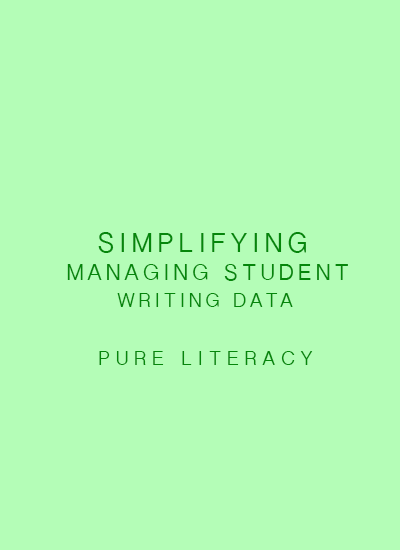So as promised, in the spirit of assessment season, this week we're talking about formative writing assessments and analyzing student writing in the company of colleagues. As many of you know, the word has spread and I’ve been super busy this year supporting teachers in implementing Writing Workshop. Honestly, I feel like I have one of the best jobs ever. I visit school districts, spend time modeling lessons with amazing students, unpacking the writing curriculum and assessment tools with fabulous teachers.
One of the powerful parts of any curriculum is the assessment component, and that is so true of the New Units of Study Writing Curriculum. Last week on the blog we talked a bit about assessment in my Assessment Shoptalk: Data Driven VS Student Driven post. It's no surprise to those of you who read the post, that I am a huge believer in looking at what a students' strengths are and build from there. While attending TCRWP Reading, Writing and Coaching Institutes at Columbia University's Teacher College, I learned that reading and writing steps could be broken down into "moves" students could follow. This resonated with me, having been a Reading Recovery trained interventionist, analyzing students' reading and writing behaviors, finding their strengths, and nudging them along a progression of skills just made sense. So in this post, we'll explore how to do just that.
Many of the school districts I support are finding that when teachers receive staff development in teaching writing, and equally important analyzing student writing, their schools are developing strong writing communities. As an outgrowth of these writing communities, teachers are developing their efficacy in analyzing student writing and writing behaviors and have been able to provide students with clear, sequenced and targeted writing instruction. This is making a dramatic difference for students. For many of these children, their ability to write in all Common Core Writing text types is impressive, but this targeted writing instruction is yielding dramatic and significant reading progress for these youngsters as well. Writing guru Lucy Calkins reminds us, “Powerful writing instruction produces visible and immediate results.
So what is making the difference? These districts have committed to invest in dedicating regularly scheduled blocks of time for teachers to engage in the practice of looking at student writing assessments, or "on-demands", closely using the rubrics from Writing Pathways. Holding these "norming" meetings, as Lucy calls them, we met as grade level teams to analyze student writing. During these meetings, thoughtful teachers were armed with learning progressions, grade level/text-type specific rubrics, and student writing samples. Stacks of papers were everywhere!
We wanted to analyze the writing thoroughly (being true to the rubric), plan our next teaching point, and yet be efficient. Then, it struck me, there had to be an easier way to transfer the information from the rubric and, more importantly, identify the next teaching point to each individual student’s writing sample. I had an idea… all we needed was to reduce the rubric, run off multiple copies to be used with each student sample. As we scored, we identified the next step teaching point by highlighting it on the reduced rubric which was attached to each student's paper.
Here’s how we leveled papers using the reduced rubric. First, as a grade level group, we read through the text-type specific writing rubric from Writing Pathways and highlighted key concepts and terms. We felt this activity would undergird our understanding of the rubric. Next, each teacher scored each student’s post on-demand writing using the rubric as a guide. As they scored, they marked the individual's reduced rubric noting the student’s level and identified the next area of teaching, or teaching point, for that student to lift their level of writing. The information collected during scoring was used in a variety of ways beyond the norming meeting. Many teachers used it to guide their small group and individual conferences. Others copied the teaching point chosen from the rubric on a separate post-it and left it in students’ writing notebooks as a reminder after a conference or a goal setting device. So many teachers I’ve worked with have found this a useful step to help identify and focus on students’ next steps. So, I wanted to share this simple but effective idea with you. And to remind you, it's not about the score but the information collected that will guide your next instructional steps with your writers.
According to research by John Hattie, and others, when teachers provide clear, specific feedback that details accessible next steps for learners it accelerates their progress. According to Hattie visible learning and teaching occurs when teachers see learning through the eyes of students and help them make deliberate steps or learning goals with the student. This is the power of reviewing and reflecting on formative assessment data. My hope is that this suggestion will simplify this process and help you in supporting your students achieve those goals.
I’d love to hear your thoughts on formative assessments in writing and what systems you have in place to support your students in order to make their writing stronger. If you've created a system that supports you and your team I'd love your feedback.
Next week I'll be announcing Pure Literacy's first summer book club list! I'm really excited to launch the first ever Pure Literacy summer book club and would love your input on what books you'd like to see on the list! Are there books on your summer reading list you've been meaning to get to? Write in via the comments section below or the Ask Anything in the blog sidebar and I'll take them into consideration!
Until next week, as always, thanks for visiting me here.
Happy Reading!

